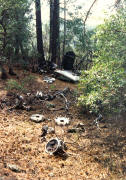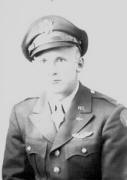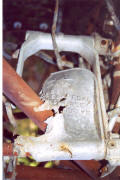|
|

Three USAAF AT-6 Texans in the Bradshaw Mountains near Crown King, March 25, 1944
Three AT-6C “Texans” departed from Luke Field at 3:55 p.m. on March 25, 1944, for a 3½ hour proficiency flight. One AT-6 was piloted by 2nd Lt. James Akridge, 19, from Memphis, Tennessee, and his student, class 44-E Aviation Cadet William Johnson, 23, from Little Rock, Arkansas. John Hesse, 20, from Eugene, Oregon and Harold Brinkman, 20, from Clarksville, Iowa each had their own aircraft. Each of the pilots had arrived at the School Operations Office earlier in the afternoon and obtained clearance to fly separately within the local area from 2:45-6 p.m. They had each planned on honing their piloting skills to become more adept in the AT-6 single-engine trainer. As with any other day on the busy airfield, the take-off was uneventful and went unnoticed by the ground crew personnel who busily went about their duties. The loud drone of the radial engines slowly faded and the planes disappeared into the scattered, billowy clouds. Neither the pilots nor the ground crew had any idea that, in a few hours, this three-plane formation was going to end in disaster. The weather that afternoon consisted of moderate turbulence and scattered cumulus clouds with a cold front forming. Further north of Phoenix, the wind started to pick up and there were reported gusts of up to 30 mph. Six p.m. came and went without any word from the three aircraft, and by 9:45 p.m. they were officially reported as missing. Because of the high winds prevailing during their scheduled flight, some pilots and base officials speculated that all three aircraft exhausted their gasoline supply and had been forced down in a remote area. With only enough fuel for 3 1/2 hours of flying, they were definitely on the ground, whether on a solitary auxiliary emergency landing strip, or worse, crashed somewhere in the vast Arizona terrain. Base officials had no idea where to start their search since all three of the pilots had not indicated to the Flying Operations Officer where they planned on flying. To further complicate the issue, it was never verified whether the planes were going to fly solo or together in a formation flight. Luke Field had a real problem; in the last 3 months, they had a total of five AT-6 trainers disappear. On the evening of December 21, 1943, aviation cadets George Fischer and Ralph Heil departed Luke Field in their AT-6’s for a night navigation training flight that would take them to Yuma, Red Rock and back to Luke Field. Both planes checked in as they were flying over Yuma, but were never heard from again. Countless hours were spent flying over the southwestern area of the state, as well as Mexico, without turning up any clues. Over a year later, on March 29, 1945, while searching for another lost aircraft from Luke Field, the Civil Air Patrol found cadet Heil’s remains in the wreckage of his AT-6 where he crashed in the Maricopa Mountains. It is not known if Fischer’s plane has ever been located. At 9 a.m. on March 26, 1944, Luke Field initiated a search for the three missing aircraft. Neighboring USAAF installations were notified and furnished with information on the pilots as well as the aircraft’s manufacture type and serial number. All Luke Field flying personnel were made aware of the situation and advised to remain alert for the wreckage or any distress signals from the downed crew. Over the following week, AT-6’s manned with a pilot and observer, conducted 147 search missions from the high mountains to low deserts scouting for any signs of the aircraft or crew. Aircrews flew inside of an area bounded from Kingman, to Blythe, to Tucson, to Benson, into New Mexico and up to the Grand Canyon. All areas were covered twice, but some rugged landscape, like the San Francisco Peaks or Grand Canyon, were flown over three or four times. There were daily flights until April 1, at which time the search was abandoned. The families of the men were notified they would be advised as soon as they were discovered. A general alert was put out to all aircraft flying in the area with hopes that some trace of the missing aircraft might be found. On July 28, just over 4 months after they crashed, a Luke Field aircraft flying near Crown King in the Tower Mountains spotted silver aluminum among pine trees that appeared to be a plane. The following day, crash investigators made their way down the steep canyon and found that the plane had ‘bellied in.’ Although the plane had been damaged upon impact, it was in surprisingly good condition with the wings and fuselage relatively intact. The plane’s identity was confirmed by the serial number as that of 42-49009, the AT-6 flown by Johnson and Akridge. Johnson had been killed instantly by the impact and his body was still in the canopy. What puzzled the investigators was that Akridge’s body was nowhere to be found. Had he seen they were going to crash and bailed out at an altitude too low for the parachute to blossom? Or had he survived the crash and tried to find his way out of the forest, only to become lost and succumb to the snow and freezing weather? While combing the forest looking for his body, they were able to locate the two other AT-6’s. The two Texans, serial numbers 42-49038 and 41-32938, had crashed a quarter mile further up the canyon. These two planes had hit much harder and the twisted, burned remnants were all that remained. Officials never had a definite answer as to how the planes ended up where they did. It appeared that the formation had tried to fly up the canyon just above treetop level and, not realizing there was a strong downdraft until it was too late, simply didn’t have enough horsepower to climb out. Small amounts of wreckage, including part of a tail section, that were scattered down a slope above the crashes indicates where they had tried to turn around, but instead clipped the trees on a ridge before plunging into the canyon below. On October 5, 1946, two hunters made a discovery that would close the mystery on the fate of Lt. Akridge. While scouting near the summit of the Bradshaw Mountains north of Crown King, they discovered his partial skeleton clad in a tattered flight suit. Lt. Akridge had indeed survived the crash and attempted to limp out despite being injured. He had made his way over two miles through rugged forest, snowdrifts, and freezing weather before dying of shock and hypothermia. On March 25, 2009, the 65th anniversary of the the crash, I had the opportunity to take Pam Burns, niece of Lt. Harold Brinkman,her husband Don and son Jayden to the crash site. |
AT-6C #42-49009 flown by Lt's Akridge and Johnson
 |
 |
 |
| The disassembled engine. | The tube frame is still mounted onto the center section of the wing. The yellow paint signifies it is a known crash. | The Texan's aileron. |
AT-6C #42-49038 flown by Lt John Hesse Jr.
|
|
|
|
|
| The tube frame. | Wing section. | Exhaust manifold data plate. | More debris. |
AT-6C #41-32938 piloted by Lt. Harold Brinkman
 |
|
|
|
| A faded photo of Lt. Harold Brinkman. | Rear portion of the cockpit. | The engine nacelle with paint remnants. | The center section. |
|
|
|
 |
|
| Holding a section of fuselage. | Data tag in the cockpit section. | A rudder pedal. | Pam Burns sitting in the front cockpit of her uncle's plane. |
|
|
|
| Memorial for Lt. Harold Brinkman left by Pam, Don and Jayden. | Pam, me, Jayden and Don holding the tail section to her uncle's plane. |